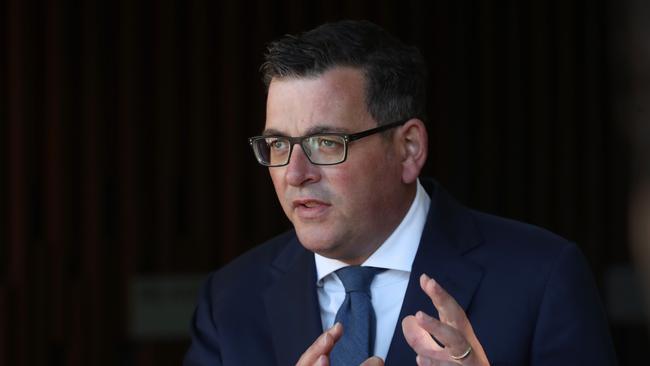Matthew Guy Mark II: ‘It’s like he’s on Mogadon’
The fog is starting to lift on Victoria’s finances, Daniel Andrews and the reincarnation of Liberal leader Matthew Guy, who’s put away his flick knife and changed tack.
For the first time in years, the Victorian Liberal Party is quietly confident that its fortunes in the state parliament are starting to change and will weather the battering of its brand, exacerbated by Scott Morrison’s low standing in the state.
The Liberals believe they will profit, potentially substantially, from the woes facing Labor, which go significantly beyond just the pandemic.
As you would expect, Guy’s recently released pre-election manifesto details the enormous political challenges facing the Andrews government as it limps towards the November 26 election.
Labor’s pandemic baggage is neatly boiled down in the manifesto: “Six lockdowns, over 2000 Victorian deaths, the curfew, failures in contact tracing, the hotel quarantine debacle, eight consecutive interrupted school terms, playground bans, travel bans, the initial ban on seeing intimate partners, the refusal to release health advice, the authorised worker permits, the public housing tower lockdowns, the social isolation, the contradictory approach to different public protests, and sudden border closures – amongst many other government decisions – have left people and their communities exhausted.”
Then there is the elephant in the room, the looming $160bn worth of state debt by mid-2025, the soaring tax take, internal Labor dysfunction that has led to numerous ministerial sackings or resignations, anti-corruption hearings, a volatile upper house and deep trepidation about how the state will return to work after the relaxation of virtually all restrictions.
It looks so messy for the government. Labor’s struggles this week to introduce a $800m social housing tax are emblematic of the political climate. This at the time voters are looking for stability and incumbent governments across the country are under deep post-pandemic scrutiny.
Two weeks ago the Opposition Leader launched a 44-page document outlining the key principles he would be following, spearheaded by no more lockdowns, fixing Victoria’s struggling healthcare system, bolstering mental health and the business sector, and addressing cost of living issues.

In what was a week of election campaigning simulation a fortnight ago, senior sources said the party also polled a series of key seats the Coalition needs to win to plug the gaping hole in the lower house; it has 26 seats in the 88-seat lower house, compared with Labor’s 57, and there are three Greens and two independents.
It will require an almost insurmountable double-digit, uniform swing for Guy to win office.
But this month’s Liberal polling showed the Coalition was markedly more competitive than the previous published surveying had reported.
“It’s much tighter than you would expect and the published polls are completely wrong,” one senior Liberal said. Of course, you might think, they would say that.
But privately senior Liberals have been saying for a few months that the published opinion polls have been significantly overstating the Labor vote and maybe the Prime Minister’s unpopularity has been bleeding into those surveys.
At the same time as Labor has been struggling with the weight of government, Guy has turned down the volume on his own behaviour. The irony being that Guy secured the leadership in large part because his predecessor, Michael O’Brien, was accused of not going hard enough against Labor.
The problem for O’Brien was that the advice to him was that the community did not want a confrontationalist approach to politics when millions of people were dying around the world from the coronavirus.
So what Victorians are getting now is a Guy Mark II, where the street fighter of old has put away his flick knife and is now selling himself as a calmer leader focused on the post-pandemic rebuild and recovery.
“It’s like he’s on Mogadon,” one Labor minister said this week of Guy.
Guy is starting to copy the playbook used by federal Labor leader Anthony Albanese and South Australian Labor leader Peter Malinauskas.
It’s not going to be easy for him, though. Labor has such a fat margin thanks to the 2018 rout and the government under Andrews has been a phenomenal (but sometimes flawed) political machine.
Labor knows there is a looming problem in the outer suburbs among people badly affected by the pandemic. Think small businesses, insecure workers and anyone in hospitality, travel or other sectors so smashed by the pandemic. It’s the outer ring, 20km to 30km or more from the inner-city tofu curtain.
It also knows that in the middle of the pandemic it has been much easier to paper over the cracks of a nearly two-term reformist government that has poured tens of billions of dollars into infrastructure and focused its political strategy on the public service, the regions, the university educated and a pandemic agenda of community safety over personal liberty.
Andrews knows that to survive the next election, which he probably will, he will need to shore up regional Victoria and ring fence as many inner-city seats as he possibly can.
The decision to bid for the Commonwealth Games is all about the politics of the regions, where many of the events would be held. It is reckless financially when the state budget is under critical pressure but it will be greeted warmly in the big regional cities that are becoming increasingly locked in Labor.
Don’t expect Andrews to suddenly stop writing cheques between now and the election because it has been huge spending, fuelled by debt and record taxes, that has enabled him to implement his strategy.
He knows most voters accept that debt is a part of modern life; Victorians are living in a post-Jeff Kennett world. It’s when they don’t see any dividends, be that level crossings are removed, schools built or traffic blockages addressed, that it becomes a polling booth issue.
Andrews has ruthlessly exploited this dynamic, the impact of the pandemic on daily politics and the way social media has created a toxic short-term approach to policy and debate.
By the time of the Victorian election, Labor will be banking on the pandemic phase having segued to the recovery phase. By which time it will have a colossal infrastructure agenda (peppered with cost overruns) to point to and a record of sweeping social reform that has been embraced by left of centre voters, particularly inner-city greens.
These are big hurdles for Guy to leap.
The challenges are reminiscent of Kennett in 1988 in the election he lost before the Cain-Kirner governments fell apart. Like then, the state’s finances were the political iceberg sitting in Port Phillip Bay.
The pandemic clearly will feature strongly in the campaigning, but just how the community marks Andrews’ cards is somewhat opaque.
As Guy has pointed out, there have been a large number of mistakes, especially in 2020. But when seen through the prism of the global experience, Australia (and Victoria) has done relatively well.
Where Labor is most vulnerable in the medium term is in its budget and through entities such as its workers compensation scheme, which faces surging liabilities and crippling losses.
The Covid-19 pandemic has been awful. But the next term will be all about the money. We have yet to have a serious conversation about budget repair.




The fog is starting to lift on Daniel Andrews, Victoria’s creaking finances and the reincarnation of Liberal leader Matthew Guy.